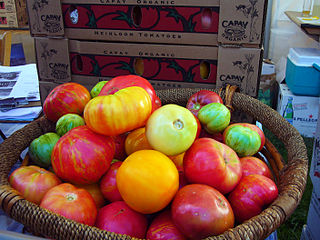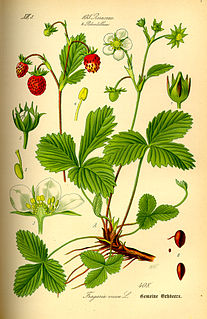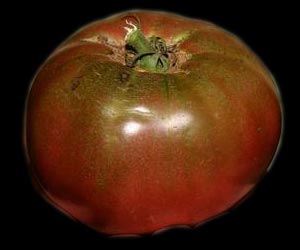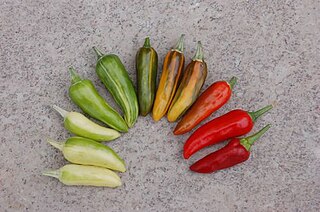
The potato is a starchy tuber of the plant Solanum tuberosum and is a root vegetable native to the Americas. The plant is a perennial in the nightshade family Solanaceae.

Eggplant, aubergine or brinjal is a plant species in the nightshade family Solanaceae. Solanum melongena is grown worldwide for its edible fruit.

The avocado, a tree likely originating from south-central Mexico, is classified as a member of the flowering plant family Lauraceae. The fruit of the plant, also called an avocado, is botanically a large berry containing a single large seed. Avocado trees are partially self-pollinating, and are often propagated through grafting to maintain predictable fruit quality and quantity.

Physalis peruviana, is a South American plant native to Colombia, Ecuador and Peru in the nightshade family (Solanaceae), commonly known as Cape gooseberry or goldenberry, known in its countries of origin as aguaymanto, uvilla or uchuva, in Hawaii called poha, and in Egypt called Harankash, in addition to numerous indigenous and regional names. The goldenberry is also known as ground cherry. The history of P. peruviana cultivation in South America can be traced to the Inca Empire. It has been cultivated in England since the late 18th century, and in South Africa in the Cape of Good Hope since at least the start of the 19th century. Widely introduced in the 20th century, P. peruviana is cultivated or grows wild across the world in temperate and tropical regions.

An heirloom plant, heirloom variety, heritage fruit, or heirloom vegetable is an old cultivar of a plant used for food that is grown and maintained by gardeners and farmers, particularly in isolated or ethnic minority communities of the Western world. These were commonly grown during earlier periods in human history, but are not used in modern large-scale agriculture.

An heirloom tomato is an open-pollinated, non-hybrid heirloom cultivar of tomato. They are classified as: family heirlooms, commercial heirlooms, mystery heirlooms, or created heirlooms. They usually have a shorter shelf life and are less disease resistant than hybrids. They are grown for a variety of reasons: for food, historical interest, access to wider varieties, and by people who wish to save seeds from year to year, as well as for their taste.

Fragaria vesca, commonly called wild strawberry, woodland strawberry, Alpine strawberry, Carpathian strawberry, European strawberry, or fraisier des bois, is a perennial herbaceous plant in the rose family that grows naturally throughout much of the Northern Hemisphere, and that produces edible fruits.

A beef tomato or beefsteak tomato is one of the largest varieties of cultivated tomatoes, some weighing 450 grams (1 lb) or more. Most are pink or red with numerous small seed compartments (locules) distributed throughout the fruit, sometimes displaying pronounced ribbing similar to ancient pre-Columbian tomato cultivars. While popular among home growers for beef sandwich toppings and other applications requiring a large tomato such as toppings on large steaks, beefsteaks are not grown commercially as often as other types, since they are not considered as suitable for mechanization as smaller slicing tomatoes.

A grape tomato is a class of tomatoes believed to be of southeast Asian origin, shaped similarly to the oval plum tomatoes but having the small size and sweetness of cherry tomatoes. Grape tomatoes produce small and typically oblong fruits. Introduced to the worldwide market in the 1990s, they have gained substantial popularity, due at least in part to their higher sugar content compared to regular tomatoes, and due to their smaller, bite-sized shape.

The Roma tomato or Roma is a plum tomato popularly used both for canning and producing tomato paste because of its slender and firm nature. Commonly found in supermarkets in some countries, Roma tomatoes are also known as Italian tomatoes or Italian plum tomatoes.

The tomato is the edible berry of the plant Solanum lycopersicum, commonly known as a tomato plant. The species originated in western South America and Central America. The Nahuatl word tomatl gave rise to the Spanish word tomate, from which the English word tomato derived. Its domestication and use as a cultivated food may have originated with the indigenous peoples of Mexico. The Aztecs used tomatoes in their cooking at the time of the Spanish conquest of the Aztec Empire, and after the Spanish encountered the tomato for the first time after their contact with the Aztecs, they brought the plant to Europe, in a widespread transfer of plants known as the Columbian exchange. From there, the tomato was introduced to other parts of the European-colonized world during the 16th century.

Cherokee Purple is the name of a old variety of tomato that develops a fruit with a deep, dusky-rose color while maintaining a somewhat greenish hue near the stem when mature for eating. The deep crimson interior and clear skin combination give it its distinctive color. It was one of the first of the darker color group of tomatoes sometimes described as "blacks." Southern Exposure Seed Exchange was the first seed company to offer Cherokee Purple, released in limited quantity in 1993. The Cherokee Purple has become a popular heirloom variety.

Watermelon is a flowering plant species of the Cucurbitaceae family and the name of its edible fruit. A scrambling and trailing vine-like plant, it is a highly cultivated fruit worldwide, with more than 1,000 varieties.
The Hillbilly Tomato, scientific name Solanum lycopersicum, is an heirloom cultivar originating from West Virginia in the 1800s. This fruit is considered a beefsteak tomato weighing 1-2 pounds. It is round, heavily ribbed and its skin and flesh is orange- yellow with red streaks. The flavor is described "sweet and fruity" and is low in acid.
The Amish Paste heirloom tomato is, as the name implies, a plum tomato of Amish origins, that is commonly used for cooking, although it is sweet enough to eat fresh.

Aunt Ruby's German Green heirloom tomatoes are a cultivar originating with Ruby Arnold, of Greeneville, Tennessee, but achieving great Seed Savers popularity. They are, as the name implies, "green" tomatoes, which really means they are a greenish yellow when fully ripe, but are still tasty when picked early.

The Celebrity tomato cultivar is a hybrid (biology) that produces long fruit-bearing stems holding 20 or more very plump, robust tomatoes. Fruits weigh approximately 8 oz., and are 4 inches across. Plants need caging or staking, and produce fruit throughout the growing season. The celebrity tomato is a cultivar of the species Solanum lycopersicum. It is a crossbreed of the common tomato that is widely used for various culinary purposes. This tomato is of great size and is known to be resistant to most tomato diseases such as Fusarium wilt, Verticillium wilt, Tobacco mosaic virus and Root-knot nematode due to its hybrid nature. Celebrity tomatoes are highly adaptive to harsh environments and can grow in a wide range of places including dry, humid and wet regions. They are resistant to cracking and splitting which usually occurs when there is an excess of water and sugar movement in the fruits. Therefore, causing the tomato skin to grow at a slower rate compared to the expansion of the fruit. They can survive in harsh uneven rainfall. However, they are highly susceptible to colder environments and are at a higher risk of dying in regions with short growing seasons. The plants can grow up to 5 feet in height with bright red medium-sized fruits. The plants are generally very thick and grow in clusters. The tomato fruits are mostly used in the making of various salsas, salads, juices and canned food.

The fish pepper is a small Chili pepper cultivar of the species Capsicum annuum. It is a historical variety from African-American communities in the Chesapeake. The plant has variegated foliage and the peppers ripen from white with green streaks to a dark red color. Its pungency can range, with scoville heat units from 5,000 to 30,000.
The Jersey Boy tomato is a type of beefsteak tomato in the family Solanaceae, a hybrid cultivar of the Rutgers and the Brandywine tomatoes by Burpee Seeds. It made its first appearance as commercial seed registered 2014 and released circa 2015.


















